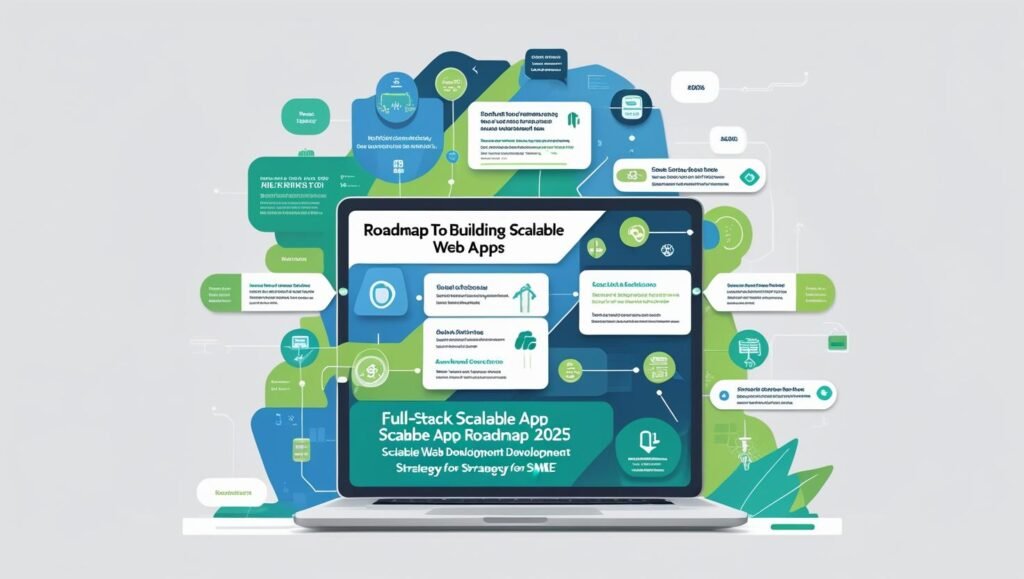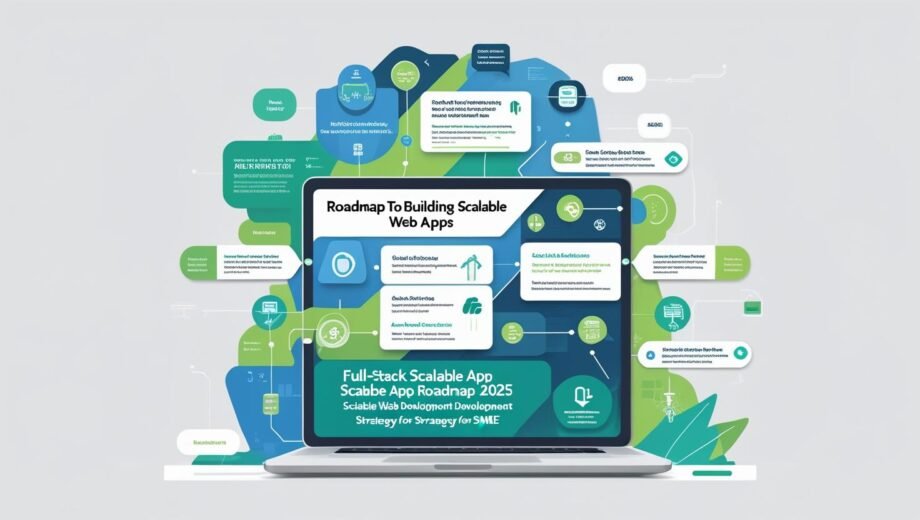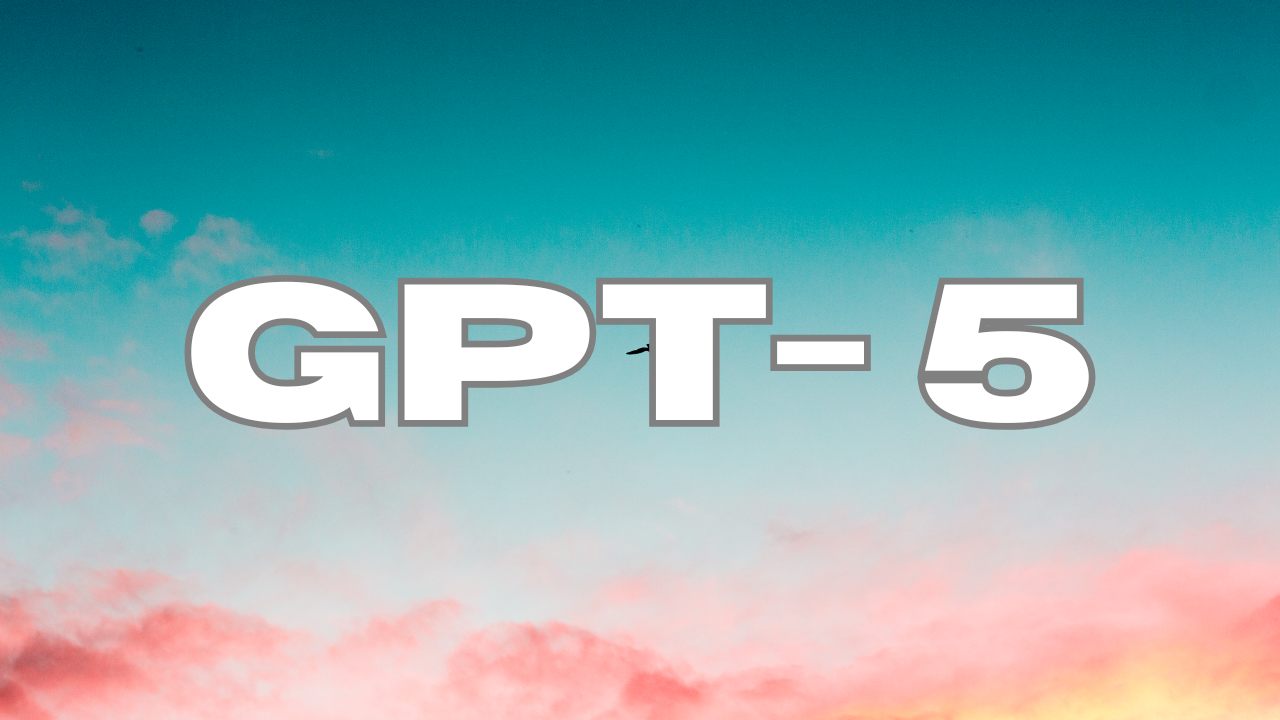Introduction: Embracing Business Tech in 2025
Small and medium-sized enterprises (SMEs) are rapidly embracing digital transformation in 2025. Technologies like cloud computing, AI, and automation are no longer optional—they are the backbone of scalable, secure, and modern business operations.
Question: What tech should SMEs adopt to develop scalable, full-stack web applications?
This Full-Stack Scalable App Roadmap 2025 offers a strategic blueprint for SMEs and developers looking to build scalable web applications using modern tech:
- 🌱 Build scalable full-stack business apps
- 🔒 Automate securely with cloud-native tools
- ⚙️ Upgrade IT infrastructure and digital operations
- 📈 Grow intelligently in digital marketplaces
Whether you operate in the USA or UK, this roadmap will help you identify the right tools and platforms to thrive.

📌 1. Cloud Computing: Powering the Foundation of Scalable Apps
✅ Why It Matters:
Cloud platforms are the foundation of scalable full-stack development. They offer high availability, instant scalability, and seamless integrations.
🚀 Top Cloud Tools:
- Google Cloud Platform (GCP)
- Amazon Web Services (AWS)
- Microsoft Azure
Key Benefits:
- Secure, real-time database access
- Elastic scalability
- Integrated services: storage, functions, AI
Tip: Use localized data centers for speed and compliance with GDPR and CCPA.
2. AI-Powered CRM & Sales Automation
Why It Matters:
AI-based CRM tools help automate customer management, personalize user journeys, and improve sales efficiency.
AI CRM Tools:
- HubSpot CRM + AI
- Zoho CRM + Zia AI
- Salesforce Essentials
Use Case:
SMEs can cut response time by 60% and boost conversions by integrating AI-based lead scoring and outreach.
3. Financial Automation: Go Beyond Spreadsheets
Essential for Modern SMEs:
Tracking cash flow, invoices, and taxes at scale requires more than spreadsheets. Full-stack developers should integrate finance APIs and accounting solutions.
Financial Tools:
- ✅ QuickBooks (top choice in USA & UK)
- Xero
- FreshBooks
Key Features:
- Invoice automation
- Tax calculation
- Integration with sales tools like Shopify
Region-specific integrations available for VAT (UK) and CCPA (USA) compliance.
4. Cybersecurity: Protect What You Build
Why It’s Critical:
With 43% of cyberattacks targeting SMBs in 2025, data protection is a development priority.
Cybersecurity Tools:
- Bitdefender GravityZone
- Norton Small Business
- LastPass for Teams (password management)
Best Practices:
- Use multi-factor authentication (MFA)
- Regular system backups
- Encrypt sensitive data
5. E-commerce & Omnichannel Integration Frameworks
Why It Matters:
Consumer behavior is omnichannel. Connecting web apps with e-commerce tools is necessary for customer engagement and performance tracking.
Key Tools:
- Shopify (headless & full store options)
- Square POS
- Mailchimp (email automation)
Example Integration:
Shopify + QuickBooks = Automated revenue tracking and tax configuration.
Businesses that integrate e-commerce and POS double visibility and conversion.
6. Remote Work in the Full-Stack Scalable App Roadmap 2025
Essential in a Post-COVID World:
Remote and hybrid work is the norm. Apps that simplify digital collaboration are in high demand.
Top Tools:
- Slack (communication)
- Zoom or Google Meet (video calls)
- Trello or Asana (project management)
🎯 Benefits:
- Increased employee satisfaction
- Lower operating costs
- Global talent sourcing
Bonus: Emerging Tech to Watch
Worth Early Adoption:
- AI Chatbots – Use ChatGPT or Dialogflow to automate routine queries
- Blockchain – Transparent ledgers, smart contracts
- Voice Search Optimization – Tailor content for Siri and Alexa
These new technologies, while optional, can give SMEs a head start in automation and innovation.
Implementing this Full-Stack Scalable App Roadmap 2025 gives SMEs a competitive edge in digital development.
Local Considerations: USA vs UK
🇺🇸 USA Trends:
- High AI/automation adoption
- Focus on data privacy: CCPA, SOC 2
- Top tools: Shopify, QuickBooks, Zoom
🇬🇧 UK Trends:
- GDPR-compliant web infrastructure
- Affordable access to SME tech grants
- Top tools: Xero, Sage, Microsoft Teams
Resource Tip: Visit https://www.gov.uk/business or https://www.sba.gov for grants, toolkits, and business tech portals.
Every section of the scalable app roadmap for 2025 is designed around real-world SME use cases.When building apps that scale, following a solid Full-Stack Scalable App Roadmap 2025 ensures long-term growth and stability.
🧩 How to Build or Buy Your Tech Stack in 2025
✅ Step-by-Step Approach:
- Identify Your Needs – Finance, CRM, Project Management?
- Shortlist Industry Tools using sites like Capterra or G2
- Check Compatibility with GDPR or CCPA
- Use Free Trials before committing
- Train Your Teams to ensure adoption success
❓ FAQs
Q1: What tools are essential for SMEs in 2025?
A: Start with cloud platforms, CRM, cybersecurity, and QuickBooks/finance automation.
Q2: Are there tech grants for small businesses?
A: Yes. Visit SBA (USA) or GOV.UK (UK) to explore funding and support options.
Q3: What's the best accounting software for SMEs?
A: QuickBooks (for UK & USA), Sage (UK), and Xero are highly rated.
Need extra income while learning web dev? Read our guide on best side hustles for students in 2025.
✅ Conclusion: The Future-Proof Business Tech Strategy
Success in 2025 depends on choosing the right full-stack tech architecture. From QuickBooks and Salesforce to Shopify and Slack, selecting flexible, scalable platforms helps you build faster, stay compliant, and serve customers better.
Whether you're building an app or transforming your SME operations, this roadmap sets you up to:
- Adopt essential tools
- Align with compliance rules
- Build scalable, secure systems
- Thrive in a hyper-digital economy.








